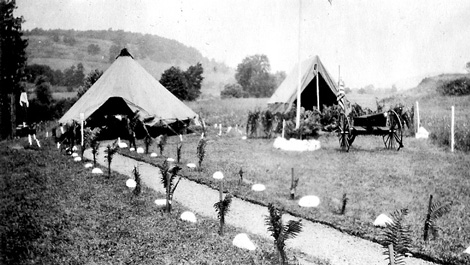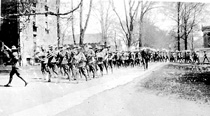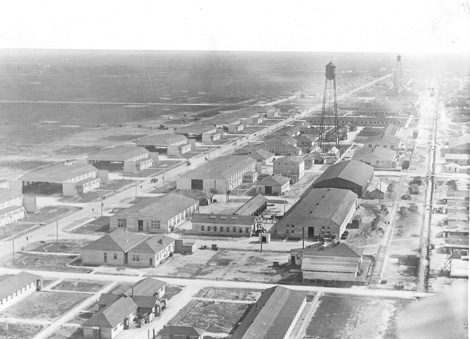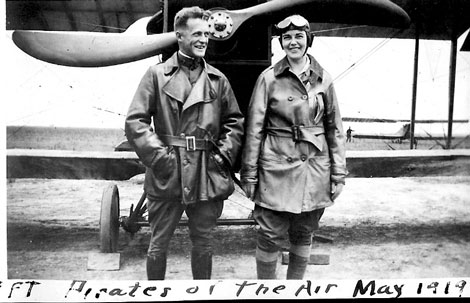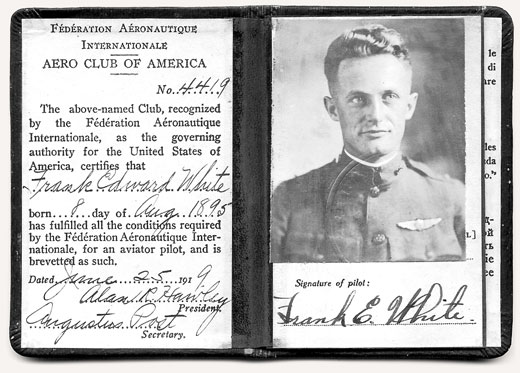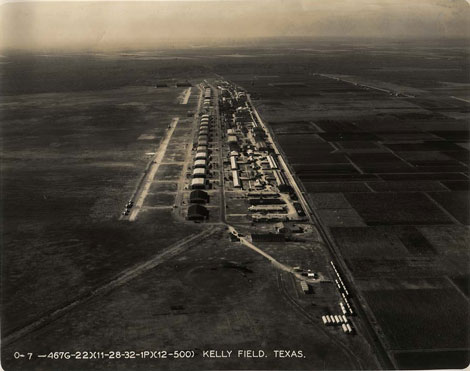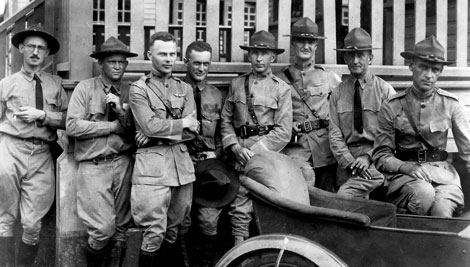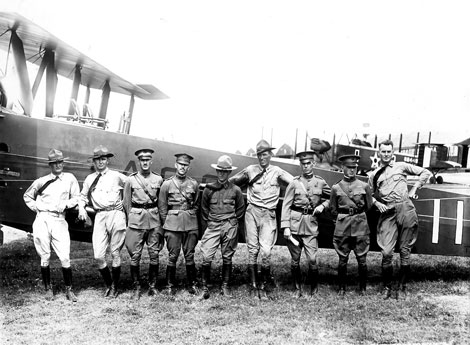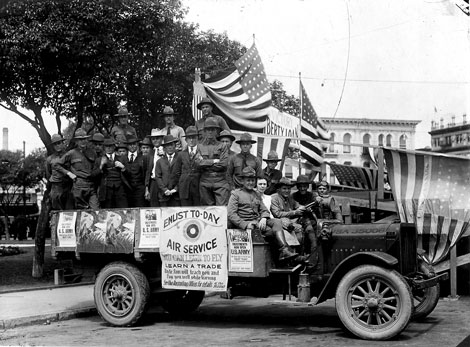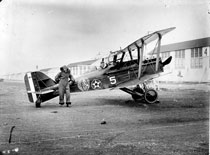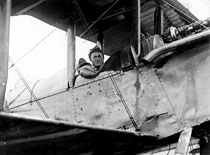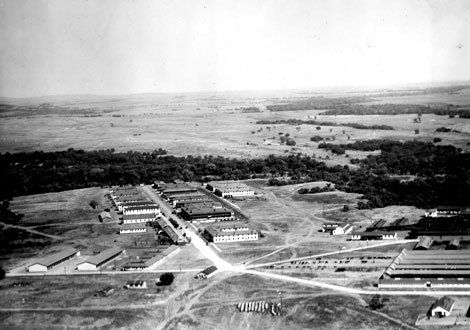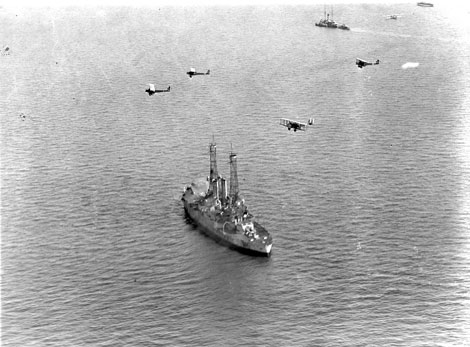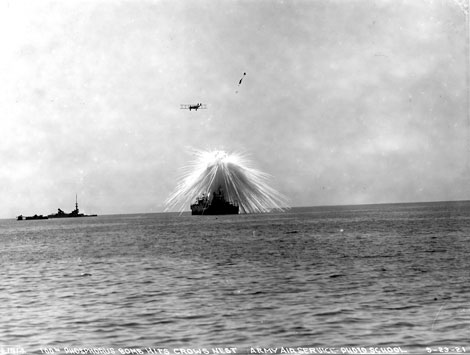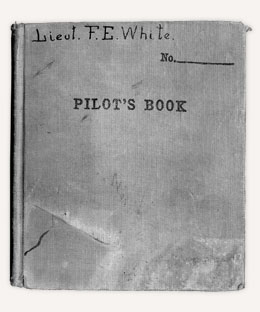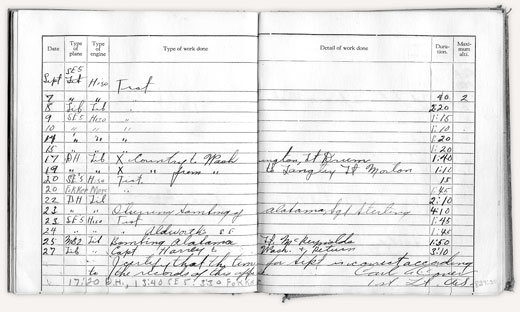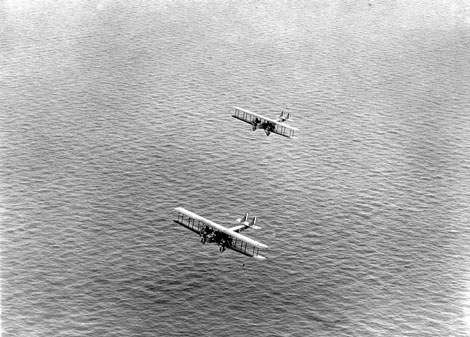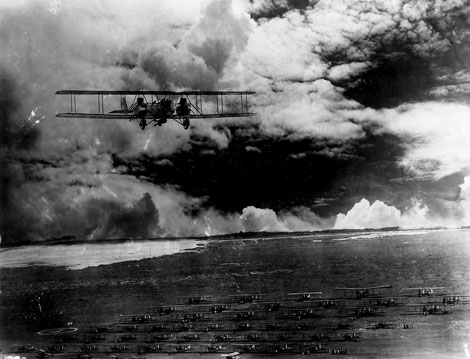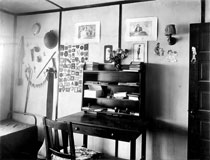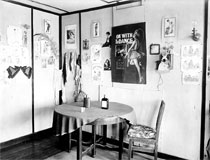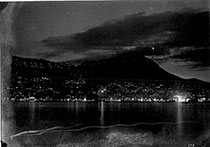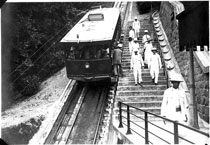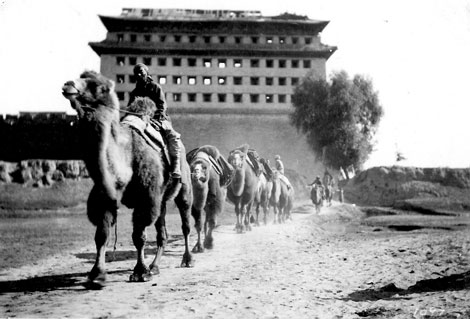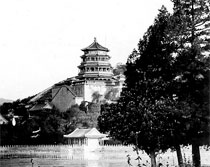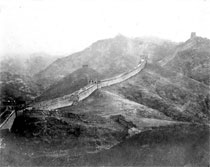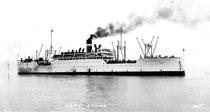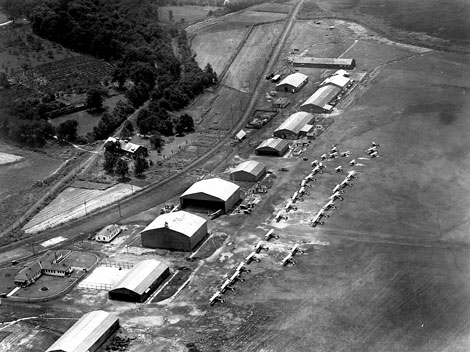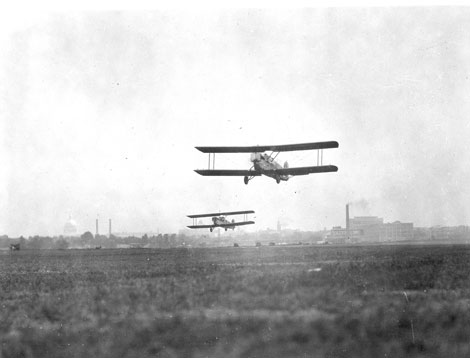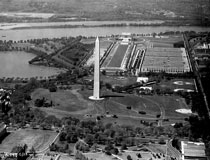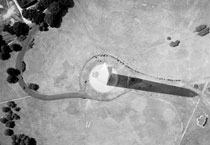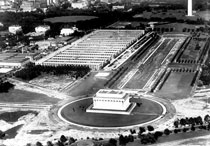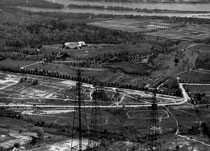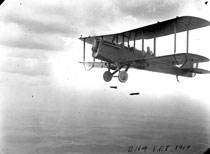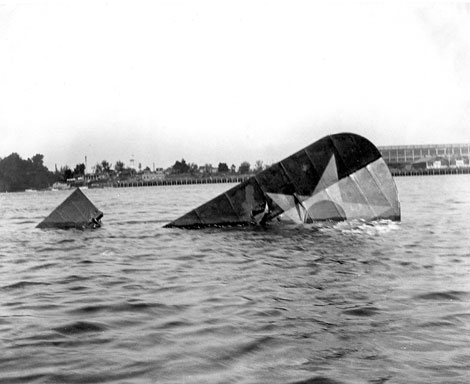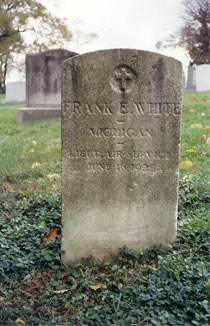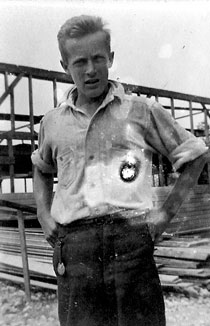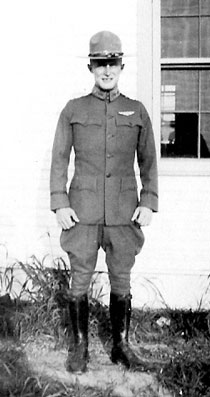
Frank Edward White
White, Frank Edward
011312Mamaroneck, New York
- Rank
- 1st Lieutenant
- Organization
- Air Service (A.S.), Regular Army
- Description
- Height: 5'-4 1/2", blue eyes, light brown hair, fair complextion, right middle finger has two brown scars
- Born
- August 8, 1895 - New Rochelle, New York (claimed Hancock, MI as home)
- Died
- July 16, 1925 - Bristol, Pennsylvania
Introduction
June 17, 1925
FORMER MEMPHIS MAN DIED IN FALL
Lieut. Frank E. White, 29, aviator in the U.S. Army Air Service, died Tuesday night in a hospital in Bristol, PA., from injuries sustained when his plane fell in the Delaware River. He was stationed at Bolling Field, District of Columbia.
Frank graduated from Hancock High School, Hancock, Michigan in 1912 and worked for three years to gain engineering experience. He entered Cooper Union in New York City on September 1915 as an engineering student. Cooper Union is the only private, full-scholarship school in the United States dedicated exclusively to preparing students for the professions of architecture, art and engineering. Frank left after one year to enter active military service at 21 years of age.
Frank’s military service took him from New York to South Carolina, several airfields in Texas, the District of Columbia, Oklahoma, Virginia, the Philippines and China. In 1924, he received an invitation to the White House from President Calvin Coolidge. Frank documented his military career, keeping all his Special Orders, notes, and an outstanding collection of personal and Signal Corps photos.
MILITARY SERVICE - 1917
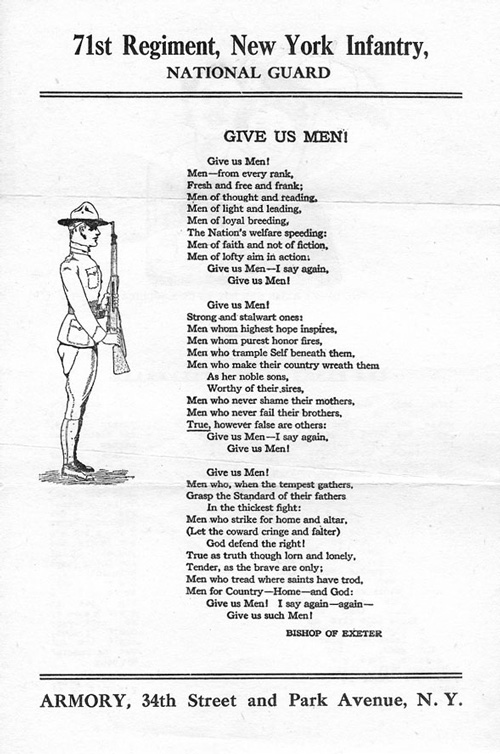
Give us men!
Frank Edward White enlisted in the 71st New York Infantry National Guard on November 17, 1916. He reported to Camp Rendezvous on March 26, 1917, and launched his military career as a Private and then a Private 1st Class with Co. D of the 71st NY NG. They were federalized and called to active service guarding railroad property and bridges in Sidney, New York until July 1917.
Camp Rendezvous - March 26, 1917
Between August 11 and October 11 he participated in Infantry Camp in Van Cortlandt Park, NYC. On October 12 he was transferred to Camp Wadsworth in Spartanburg, S.C. and served with the 102 U.S. Engineers through November 27, 1917.
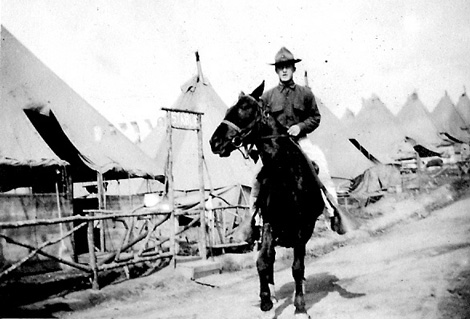
Private 1st Class White - Spartanburg, SC
On December 1, 1917, Private 1st Class White reported to the School of Military Aeronautics (S.M.A.) in Princeton, New Jersey and served there until February 12, 1918. This transfer placed him in the Aviation Section Signal Enlisted Reserve Corps (E.R.C.).
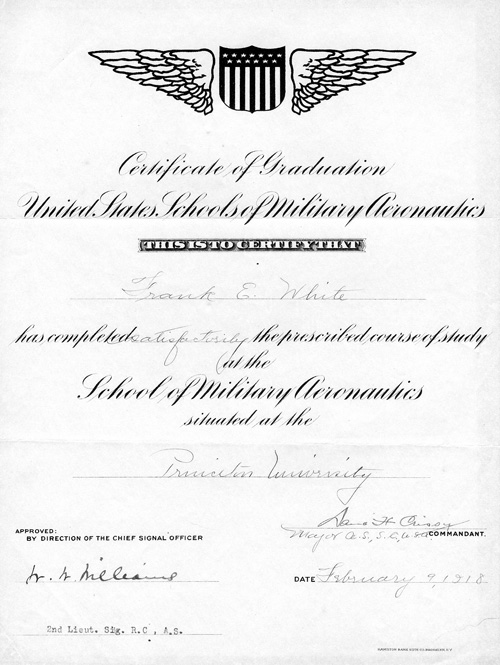
Certificate of graduation
1918
On June 26 Frank received Special Orders No 171 whereby each of those listed as Privates 1st Class, Signal Enlisted Reserve Corps, Flying Cadets, were discharged from the Service to accept a commission as Second Lieutenant U.S. Air Service, (Military Aeronautics).
2nd Lieutenant Frank Edward White, an officer of the U.S. Air Service (A.S.), (Military Aeronautics), National Army, was assigned on June 27 (Special Orders No 172) to active duty and instructed to report in person to the Commanding Officer at Headquarters, Love Field in Dallas, Texas, for assignment of duty.
On July 8 Special Orders came from Secretary of War Peyton C. March, General and Chief of Staff, at the War Department in Washington, to proceed to Dallas and report upon arrival to the commanding officer at Headquarters Camp Dick (Aviation Concentration Camp at State Fair Grounds). Frank and 2nd Lieut. Milton P. Ghee reported July 10 and were assigned to the Athletic Department.
Dallas, TX - Cadets from Camp Dick in Red Cross Parade
The next set of Special Orders directed Second Lieut. Frank E. White, Aviation Section, and Signal Reserve Corps, as on duty, requiring him to participate regularly and frequently in aerial flights from June 27, 1918.
All officers of the Air Service have the phrase “requiring him to participate regularly and frequently in aerial flights” in their orders from time to time. The detail to duty involving flying constitutes participation in one or more of the following:
- Routine test flights and test flights of new or overhauled aircraft or their power plants, instruments, equipment or accessories;
- Prescribed training of student airplane pilots, student observers or members of aircraft crews;
- Inspection of the adequacy of flight training material;
- Efficiency of instructing personnel;
- Familiarizing pilots or other flying personnel with the operation of types of aircraft, power plants, instruments or equipment with which they are inexperienced;
- Experimental development of aircraft of parts of aircraft or for experimental development of aviation instruments, equipment or accessories, training for aircraft gunnery and bombing exercises;
- Administrative or inspection purposes in connection with air work or for expediting the movement of personnel, material or mail;
- Training of reserve flying personnel flights duly authorized for the purpose of cooperation with other Governmental Departments, ferrying aircraft, aerial scouting, reconnaissance, convoy, patrol flights or training for the performance of any of these duties;
- Aerial photography, mapping, pigeon training; and
- Tactical maneuvers and for the study and observation of the physical and psychological condition of flying personnel.
Lieut. Colonel Steever granted Frank a leave of absence for ten (10) days which was extended five days, beginning July 29, 1918. Special Orders No 177 came at this time from the Secretary of War who assigned Frank and others to active duty at Love Field, Dallas, Texas from June 27, 1918.
Frank then received Special Orders No 120 from the Commanding Officer at Headquarters, Camp Dick, ordering him and others to proceed to Olcott, Texas, reporting upon arrival to the Commanding Officer, Ellington Field, for duty, not later than August 10, 1918.
Ellington (Looking South) - 1918
On September 15, Frank received Special Orders to proceed from Ellington Field to the Military Hospital, Cooperstown, New York and report in person to the Commanding Officer for observation and treatment. He arrived October 4. Periodically, all Second Lieutenants, Air Service, (Aeronautics), R.M.A.’s were continually reminded to participate regularly and frequently in aerial flights.
1919
By March 12, Frank had completed advanced training in bombing at Ellington Field and was assigned as instructor on the Accuracy Stage, reporting to Lieut. Block for duty. On April 19 he was assigned to Camera Obscura for duty, reporting to Lieut. Roberts.
Pirates of the Air - May 1919
Once again, Frank was ordered September 15 to proceed from Ellington Field to the Military Hospital in Cooperstown, New York for observation and treatment. Frank along with other officers were relieved October 11 from further treatment at this hospital, and proceeded to Mitchel Field, Long Island, New York where on October 24 he was assigned to the 866th Aero Squadron. By November 3, Frank was relieved from further duty with the 866th and detailed on Special Duty with the 5th Aero Squadron. On November 5, 2nd Lieut. White and Reise, and 1st Lieut. Gale, George, Nichols and Elliott were detailed on Special Duty with the 1st Day Bombardment Group under Lt. John D. Carmody, Air Service (A), (Class 3), and would report to him on Thursday November 6, 1919. On Dec 12 Frank was granted a leave of absence to Washington, D.C. from Dec. 13 to Dec. 14 and an additional ten (10) day leave on December 22. Pursuant to the authority contained in a letter from The Adjutant General’s Office, dated November 21, 1919, Frank and thirty-three (33) other enlisted men proceeded to Kelly Field, south San Antonio, Texas. Frank was relieved from the 1st Day Bombardment Group at Mitchel Field and told to report to the Commanding Officer, Provisional 2nd Air Park Group at Kelly Field.
1920
Frank was immediately assigned to the Provisional 2nd Air Park Group, Kelly Field, Texas, as a test pilot. He also received orders January 5 for his appointment as athletic officer of the Provisional Air Park Group. It was common for orders such as these to begin with the phrase “in addition to his other duties”. On January 8 he was assigned to the Engineering Department as Officer in charge of the Motor Division. Personnel Orders in a January 16 memo from the War Department, Office of the Director of Air Service in Washington, noted that the officers heretofore rated as Reserve Military Aviators were now rated as Airplane Pilots.
Reserve Military Aviators were now rated as Airplane Pilots.
Kelly Field
Kelly Field officers - (Left to Right) Lieutenants: C.O. Carter, J. R. Glasscock, E.E. Aldrin, Frank White, C. R. Bettis, E.A. McReynolds, M.S. Lawton, C.C. Nutt
Kelly Field officers (Frank on left)
On January 19 Frank became Acting Officer in Charge of the Air Plane Division for the 5th Air Park. On January 27 he was ordered to fly cross-country to Ellington Field, Olcott, Texas, starting the next day, and returning January 31. Upon his return he was assigned to the 2nd Air Park.
In April, and under Special Orders of Colonel Miller and Major General Dickman, Frank and several officers were directed to proceed by rail from Kelly Field to Dallas, Texas, for the purpose of flying seven (7) airplanes from the Aviation General Repair Depot to Kelly Field, Texas.
On June 28, the President of the Examining Board at Kelly Field received the following recommendation from Robert J. Brown, Jr., First Lieutenant, Air Service, recommending Frank for a Regular Army Commission. He wrote:
It has been brought to my attention that Lieutenant Frank E. White has applied for authority to take the examination for appointment in the Regular Army. As Officer in Charge of Training at Ellington Field, Houston, Texas, for over a year, I had ample opportunity to observe the character and qualifications of Lieutenant White, and I take pleasure in highly recommending him for a permanent commission in the Air Service of the Regular Army. As flying instructor and stage commander, Lieutenant White exhibited excellent spirit and initiative. At all times he showed exceptional ability, keenness and devotion to duty. He is ever ready to shoulder responsibility, and always gets the best results from his endeavors. I strongly recommend that Lieutenant White be commissioned in the Regular Army in a grade commensurate with his educational qualifications and experience, resulting in the exercise of large responsibilities during the war and since the Armistice.
Air Service recruitment - March 1920
In compliance with instructions from the War Department dated September 10, 11 and 16, Major Pratt ordered several officers, including Frank of Flight “B”, 104th Aero Squadron, to proceed from Kelly Field by airplane to Post Field, Fort Sill Oklahoma, for temporary duty, for the purpose of co-operating with the Bureau of Mines in a project approved by the Assistant Secretary of War. They proceeded to Oklahoma City for the purpose of salvaging an airplane which had been wrecked.
Fort Sill, Oklahoma - September 1920
Frank was ordered to report to the Commanding Officer of the Air Service Observation School at Fort Sill. Both Lieutenants White and Sheridan were relieved from further duty with their present organizations, and attached to the 104th Aero Squadron, Flight “B”, for temporary duty at Post Field, Fort Sill, Oklahoma. Upon arrival Frank served as Assistant Officer in Charge of Flying.
Frank was discharged from the Officers’ Reserve Corps and accepted a Regular Army Commission on September 20, 1920. Flight “B”, 104th Aero Squadron returned to Kelly Field November 1. On the 5th, Frank, four (4) other officers and twenty-nine (29) enlisted men of Flight “B” were ordered to proceed to Airdrome, Marfia, Texas for duty.
By Nov 8, Frank’s orders to proceed to Marfia were revoked. Major Spatz had ordered Frank to be placed on Special Duty with the 1st Day Bombardment Group, for duty in connection with the training of Flying Cadets. On December 1, 1st Lieutenant Benton A. Doyle, Air Service Operations Officer, ordered Frank to make a long distance reconnaissance flight to Laredo, Texas for training purposes. He left on December 4, 1920, returning the next day.
1921
Frank was notified that he had successfully completed another course at Unit School for Officers, Kelly Field. He scored 76% in Field Service Regulations. One month later, Frank’s studies proved successful with a grade of 93% in the course on MILITARY LAW based on the Manual for Courts-Martial, U.S. Army.
On February 12 Frank received orders from Major General Dickman with the 8th Corps Area, to proceed by airplane to Fort Bliss, Texas, for the purpose of ferrying airplanes from the San Antonio Air Intermediate Depot, San Antonio to that station. Typical pay for duties away from the home station was a maximum $8.00 per day for “actual and necessary expenses.” On March 6, Special Order No 56 was issued to proceed by airplane to the Aviation Repair Depot in Dallas and return by airplane for the purpose of ferrying airplanes to Kelly Field. Finally on March 11, these same orders were given for ferrying airplanes from Airdrome, Marfia, Texas to Kelly Field.
All went well except the flight to Dallas. Frank sent the following report to the Air Officer of the 8th Corps Area, Fort Sam Houston, Texas. Pursuant to Special Orders No 56, the flight for Dallas, commanded by Lieut. F.E. White, took off from Kelly Field at 1:30 p.m., Monday, March 14, 1921.
A loose Y type formation was maintained to Waco. From Waco the formation was led too far northeast. This was due to a slight error in the compass, and a greater error in judgment. The City of Corsicana was mistaken for Hillsboro and the formation was led further eastward. Shortly after passing Corsicana, it was apparent that the formation was off its course, and an immediate endeavor was made to orientate the flight by descending over the town of Athens and in reading the name upon the depot. Rejoining the flight, which was scattered, two attempts were made to attract the attention of other members. After the second attempt, four ships turned and followed the flight commander, the fifth was almost out of sight to the east and the sixth was nowhere to be seen.
Realizing that the gasoline supply was not sufficient for any further flying off the course, the flight was headed northwest for Dallas, hoping that the other two members would see the flight and turn and follow. Being engaged in the cockpit for three or four minutes and checking the map, the flight commander did not see the four ships turn and follow the ship going east. The flight commander knew that they would not go beyond Tyler, a town of considerable size with two or three emergency landing fields in the immediate vicinity. The flight commander continued straight to Dallas.
Upon arriving at Love Field, we immediately wired Tyler for information regarding the flight. Reports that came in later showed that one ship, which turned again and was following the flight commander, at too great a distance to be seen, had landed in a muddy field. Cadet Parks made a safe landing at Canton. Cadet Kenyon wrecked at Chandler, Texas, hitting a fence landing in a small field. The four ships that had landed safely were flown to Love Field as soon as they had been serviced. The crews were then reorganized into new flights that were sent back to Kelly Field.
Despite this event, Frank received notice on April 6 that the Adjutant General in Washington had promoted him to the grade of First Lieutenant in the Air Service with rank from July 1, 1920. He was instructed to fill out the enclosed form of acceptance and forward it without delay to The Adjutant General of the Army.
On May 9, The Adjutant General of the Army, Chief of Air Service sent out the following order titled “Avoidance of Publicity in Connection with Bombing Experiments.”
By Order of the Secretary of War:
U.S.S. Alabama - September 24, 1921
Special Orders No 115 arrived May 16 and by order of Major Reynolds, Headquarters 8th Corps Area, the 49th and 96 Squadrons (Bombardment) consisting of a number of officers (including Frank), Flying Cadets and 230 enlisted men, proceeded under the command of Major Henry J.F. Miller, Air Service, from Kelly Field, Texas to Langley Field, Hampton, Virginia, by rail, reporting upon arrival to the commanding officer, for temporary duty in connection with experiments in bombing naval vessels from aircraft, and upon completion of this duty returning to Kelly Field. Their focus would be the bombing of the U.S.S. Alabama. Field, personal and Squadron equipment less tentage and rations for five (5) days were carried, and officers and cadets took bedding rolls.
By Special Orders No 115 on May 21 and Major Hensley of Headquarters Langley Field, the following officers, were certified as physically qualified for flying duty by the Flight Surgeon, and were announced as on duty requiring regular and frequent participation in aerial flights effective May 20, 1921.
- Captain Byrne V. Baucom, A.S.
- 1st Lt. Richard T. Aldworth, A.S.
- 1st Lt. Levi I. Berry. A.S.
- 1st Lt. Roland Birnn, A.S.
- 1st Lt. Charles Douglass, A.S.
- 1st Lt. Samuel G. Frierson, A.S.
- 1st Lt. Edward R. McReynolds, A.S.
- 1st Lt. Stanton T. Smith, A.S.
- 1st Lt. George P. Tourtellot, A.S.
- 1st Lt. Solomon L. VanMeter, A.S.
- 1st Lt. Frank E. White, A.S.
- 1st Lt. Ennis C. Whitehead, A.S.
- 1st Lt. Edward W. Raley, A.S.
Billy Mitchell in his book Winged Defense (1925) writes “Later that same summer (after the Ostfriesland had been sunk), we were given another battleship to practice on. It was the Alabama. She was towed into about thirty-five feet of water near Tangier Sound in the Chesapeake Bay (approximately 100 miles from Langley Field). Again Captain Lawson’s invincible squadron attacked the battleship. This time we went in to sink her as quickly as possible and being in shallow water, the effect of our bombs was greater. The first two thousand pound bomb did its work, she sank to the bottom in thirty seconds. Six other bombers coming behind Lawson struck her with their projectiles and within four minutes she was a tangled mass of wreckage unrecognizable as the fine ship that had been there before she was sunk. Phosphorus bombs gave a magnificent spectacular display, the lapping flames completely enveloping the ship. We put thermite, the greatest producer of heat known, on her decks and covered her with smoke clouds dropped from the airplanes. We attacked her at night and made direct hits with our bombs in the darkness.
100lb Phosphorous Bomb Hits Crow’s Nest
Again amusing things happened. One was in connection with our gas attack. Small bombs of tear gas of only one-half strength and weighing twenty-five pounds were dropped on her. They immediately pervaded the whole ship and the officers that went below became lost as they had neglected to take flash lanterns with them and in the obscurity of the hold, as it was not lighted by electricity. Encumbered by their gas masks, they were unable to find their way around. Eventually they were gotten out after a good scare, as they were afraid that the bombing would begin again while they were down there. The tear gas worked into the clothing of many of the officers so that after they went ashore, hours later, where they were staying in farmhouses, the gas exuding from their clothing caused the girls waiting on the tables at dinner to begin to cry.
The vessels observing the tests had to change their anchorage when the wind changed so as to blow the gas away from the hulk of the Alabama to them, although they were nearly a mile away. The tear gas also appeared to be carried up and down by the tide, as it is heavier than air and rested on the water.
The tests against the Alabama in many ways were more interesting than those against the other vessels away out at sea, because so many different weapons were used against her. Any number of weapons may be used against sea craft and these, of course, will be constantly developed from year to year. Chemical weapons, such as gases, phosphorus compounds and acids are enough to put any surface ship out of action.”
Pilot’s Log showing time dedicated to U.S.S. Alabama
Martins bombing U.S.S. Alabama out of Langley Field, VA
Frank was granted permission for sick leave, an absence of about thirty (30) days, effective on or about July 11 to August 11, 1921. Because his condition was incident to flying, the Office of the Flight Surgeon declared that he was entitled to flying pay for that period. Returning August 12, he was again detailed on duty requiring regular and frequent participation in aerial flights. Within the next week, Frank was appointed Superintendent of the Aero Repair Shop and all personnel were directed to report to him for instruction and duty.
August 21 Frank and 1st Lieut. Lingle, A.S. were relieved for further attachment to the 5th Squadron (Observation). Frank was immediately detailed (in addition to his other duties) on Special Duty as Assistant to the Engineer Officer.
In late October, the 49th and 96th Squadrons, Air Service, would be relieved from further temporary duty at Langley Field, Va., and would proceed by rail, via Houston to various stations. Frank returned to Kelly Field where he was relieved from further duty and assignment with the Air Park #5 and assigned to the 13th Squadron (Attack) for duty.
By November 22 he was appointed 13th Squadron Engineering Officer. Frank further advanced in December, being proficient in completing the basic courses “MANUAL OF INTERIOR GUARD DUTY” and “PISTOL MARKSMANSHIP”. He was also appointed 13th Squadron Operations Officer in mid-December and served in that capacity through the middle of January.
Martins
1922
February 1, Frank received notice of his score (85 ½%) on the basic course “ADMINISTRATION”.
He and the following First Lieutenants of the Air Service were relieved from their present duties enabling them to comply with the order to proceed to San Francisco, California, and sail on a transport on or about March 7, 1922 to Manila, for temporary duty in the Philippine Islands. The following First Lieutenants were: John H. Wilson and Ronald A. Hicks of Ellington Field, Texas; Theodore J. Lindorff, Harry A. Johnson, and William C. Gabriel of Post Field, Fort Sill, Oklahoma; Frank E. White, Edwin R. McReynolds, Malcolm S. Lawton and William J. McKiernan, Jr. of Kelly Field, Texas; Clifford C. Nutt and Bernard S. Thompson of Langley Field, Virginia; John R. Glascock, Eugene C. Batten and Frank D. Hackett of Crissy Field, California; Harry Weddington of Chanute Field, Rantoul, Illinois; Edward L. Searl, Jr., Rockwell Field, California and Morton H. McKinnon of Nogales, Arizona.
The War Department, Office of the Quartermaster General of the Army, sent instructions to the Quarter-master Supply Officer, San Francisco, General Intermediate Depot, Fort Mason, San Francisco, to furnish transportation from San Francisco to Manila for Frank and other on the Army Transport Logan scheduled to sail at noon on March 7. Authority was also granted for the shipment of Frank’s automobile, (closed car Ford, 5-passenger, 4-cylinder valued at $250), and personal property on the first available transport. Pending sailing of the first available transport, Frank reported to Headquarters Ninth Corps Area, Crissy Field, the Presidio of San Francisco.
Frank received Special Orders on February 24 that he had been appointed to a Special Court at Camp Nichols, in Rizal, Philippines (P.I.). This court, consisting of one Captain and eight 1st Lieutenants, was appointed a specific court date followed by the condition, “or as soon thereafter as practicable for the trial of such person as may be properly brought before it.”
By April 8, and by Special Orders No 17, Frank was appointed to the Education and Recreation Office and as Armament Officer at Camp Nichols.
Frank lived at the Officers’ Club on the post, remained unmarried and was extremely popular in military circles.
By order of the Department Commander, 1st Lieut. Frank E. White, A.S., 3rd Squadron (Pursuit) was required to review and critique “Heavier-Than-Air Professional Air Service Qualifications As Determined By Test And Adaptability”. Frank made three recommendations: (1) that bombs that fail to explode be allowed to remain in the ground, as digging them up is liable to cause explosion, (2) that the test on Aircraft Silhouettes be dispensed with owing to the fact that all silhouettes obtainable in the Department are of ships that are obsolete, and (3) that the test on Naval Vessel Silhouettes be changed to read — “and the type and nationality of each vessel.”
Frank’s Individual Tax Return for 1922 indicated a total income of $4,229.76.
1923
By Order of May 1 and the Commanding Officer, Frank was detached from 66th Service Squadron, and attached to Flight “B”, 2nd Observation Squadron at Camp Nichols. By Orders of Major General Read at Headquarters Philippine Department in Manila on May 16, Frank was relieved from assignment with the 3d Pursuit Squadron, Air Service, and assigned to the 26th Bombardment Squadron, Air Service at Camp Nichols. In August, Frank was ordered to serve as Quartermaster at Camp Nichols in the absence of Captain Ray. Frank was granted a leave of absence effective October 15, 1923 for thirty (30) days
In mid-November, Major General Read ordered Frank to report to headquarters, without delay, for duty as assistant air officer in connection with the preparation of war plans, upon completion of which he would return to his proper station for duty.
On December 18 Frank received Special Orders No 269 from Major General Read, relieving him from further duty in the Philippine Department, effective on the date of sailing, proceeding to San Francisco on the U.S.A. Transport Thomas, scheduled to sail from Manila on or about January 9, 1924.
Prior to leaving the Philippines, Frank provided a Clearance Report which stated that:
I certify that I am not accountable or responsible for public funds or property; that I am not in any manner indebted to the United States or its instrumentalities; that I have turned in all confidential maps, books, and publications in my possession; that I have rendered efficiency reports for those on whom I should report, and that I have invited the attention of my immediate military superior to the necessity of submitting a report in my case.”
By Special Order No 273, Frank was granted a leave of absence for twenty days, with permission to travel in China and Japan, effective on or about January 1, 1924. He was also authorized to board the U.S.A. Transport Thomas at Nagasaki, Japan, on or about January 20,1924, for his return to the United States.
This portion of a memo directed Frank to file a report upon completion of foreign travels:
For officers travelling abroad and going on detached service or leave, they must avail themselves of all proper opportunities to obtain military information especially as pertains to their branch of service. They are required to report the results of their observations to The Adjutant General of the Army within ten days of the officer’s return to his station. All members of this command are strictly cautioned to conform to foreign regulations relative to strategic zones. It is not expected, nor desired, that officers do anything in the nature of secret service work. The officer who travels in a foreign country can be a valuable aid in gathering military intelligence if he possesses or cultivates a faculty of observation. He should understand that it is an important part of his military education to keep himself informed on military, political, economic and social development in foreign countries, and he should realize that travel offers the only opportunity for first hand observation. (Headquarters Philippine Department, Office of the Department Commander. Manila, P.I., May 14, 1923)
Upon completion of his trip, he fulfilled this requirement to file the following “Report of Observations in China” on March 11, l924 with The Adjutant General, Washington, D.C. (Through Channels).
On December 30, 1923, Frank left Manila on board the S.S. Rhineland for Hong Kong. Frank arrived on January 1st and left Hong Kong on the afternoon of January 2, 1924. In his report he wrote “viewed from the Peak, several gun emplacements were observed, and in my opinion, the harbor would make an excellent seaplane base. Near Hong Kong is located the world’s second largest sugar refinery. Maximum depth of harbor 40 feet.”
Frank arrived January 4 at Takao on the Island of Formosa. “The harbor here is completely landlocked and quite large, the only entrance being between cliffs through a passage about 75 yards wide. The mean depth through the passage is about 25 feet. No defenses are observed. There were no places suitable for landing airplanes, but several large fields were observed near the city that would be very good if cleared of some old buildings.”
The same day Frank left for Shanghai and the ship ran ashore about 25 miles from the city. Two days later the passengers were taken off and they proceeded to Shanghai by tug. Nothing of a military nature was observed as he was in Shanghai only over night.
January 7 Frank left Shanghai for Peking and arrived January 10. “The train was heavily guarded and during the night searchlights covered the country alongside and ahead of the train. Peking was very interesting and I covered as much territory as possible, visiting the Summer and Winter Palaces, several Legations, the Temples of Heaven, Agriculture and Lama, and the Forbidden City. The museum in the Forbidden City is the most interesting I have ever visited. The observatory on the Tartar Wall is also very interesting.”
Qianmen Gate & Camels - Peking
“Near Peking there is an American aviator, Capt. Northridge, who takes passengers on sight-seeing flights over the city. I did not see the Captain but from accounts heard his venture has not proved very successful.”
“Left Peking for Tientsin January 14, 1924 and visited the Headquarters of the American Forces and talked to several Officers. There are three large fields near Tientsin that would be suitable for landing any type of airplane. I inspected these fields with Captain Cape, 14th Inf. and assisted him in making a report to the Chief of Air Service. Captain Cape has furnished me with copies of this report that are attached hereto.”
Frank reported on board the U.S.A.T. Thomas at Chingwanlo, China on January 16. Upon reaching San Francisco, he boarded the U.S.A.T. Somme for Brooklyn, New York and arrived there on the afternoon of February 29, 1924.
By March 6 Frank received orders from the 56th Service Squadron, (RS) A.S., Bolling Field, Anacostia, D.C., appointing him Squadron Adjutant as well as Squadron Supply Officer, on March 12 Prison Officer, and on March 19, Trial Judge Advocate of the Special Court Martial of Private 1st Class Fred R. Thomas, Headquarters Detachment.
Frank filed his Income Tax Return for Calendar Year 1923 showing a total income of $3,996.00.
Bolling Field, Anacostia, D.C.
On March 19, 1924, under Special Orders No 42, and by order of Major Clagett, Frank received the Schedule of Operations on the Model Airway, O.C.A.S. Frank was to proceed on March 24 at 8:00 a.m. by airplane from Bolling Field, weather permitting, flying the Model Airway, for the purpose of investigating and reporting upon the marking of towns and emergency landing fields on the Model Airway in conformity with the following schedule:
Monday
Lv. Bolling Field 8 AM for Moundsville, W.Va. (Langin Field) stopping a few minutes at Cumberland, Md. Lv. Moundsville 11 AM for Fairfield (Wilbur Wright Field), stopping a few minutes at Columbus, Ohio (Norton Field). Remain a few minutes at Fairfield and then depart for Mount Clemens, MI. (Selfridge Field)
Tuesday
Lv. Selfridge 8 AM for Rantoul, Ill.(Chanute Field) stopping a few minutes at Kokomo, Ind. (Wilbur Fagely Field) Lv. Chanute 1 PM for Belleville, Ill. (Scott Field)
Wednesday
Lv. Scott 9 AM for Louisville, Ky (Bowman Field) stopping a few minutes at Vincennes, Ind. Lv. Louisville 1 PM for Dayton, Ohio (McCook Field).
Thursday
Lv. McCook 8 AM for Moundsville stopping a few minutes at Fairfield and Columbus, Ohio. Lv. Moundsville 1 PM for Bolling Field stopping a few minutes at Cumberland, Md.
By Special Orders No 48 and Major Clagett, Frank was appointed Acting Post Engineering Officer on April 5. Then on June 25, he received orders from Headquarters to proceed to Blackwood Field, Tennessee, for the 30th Division Air Meet. In early July, Frank was ordered to participate on a Board of Officers, to meet at the call of the President, for the purpose of examining such enlisted men who may be ordered to appear before it for examination for promotions to the grades of Technical Sergeant and Master Sergeant. On that same date, Frank learned that he had been appointed Squadron Supply Officer.
Takeoff at Bolling Field
On July 25 Frank, along with Capt. Huddleston and 1st Lieut. Beau, Jr., were ordered to meet at 1:00 p.m. for the purpose of making a complete inventory and audit of the Post Exchange, including the following accounts: Consolidated Mess, Bachelor Officers’ Mess and the Officers’ Club. Three days later, Frank was ordered to proceed on the Model Airway, weather permitting, for the purpose of developing equipment for installation in airplanes at the various airway stations and auxiliary stations on the Model Airway.
Special Orders No 191 of September 24 ordered Frank attached to the 3d Photo Section, Bolling Field, effective the next day. On the 29th Major Clagett ordered several officers (Major Henry B. Clagett, A.S., Capt. John C. Platt Jr., O.C., Capt. Clearton R. Reynolds, A.S., 1st Lieut. Frank E. White, A.S. and 1st Lieut. Edwin E. McReynolds, A.S.) to proceed by air, to Fairfield Air Intermediate Depot, Fairfield, Ohio for the International Air Races October 1, 1924. They would return October 5.
Frank was granted a leave of absence for thirty (30) days effective November 8. The same day he was relieved from further duty with the 3d Photo Section.
1925
Flyover D.C.
Washington Monument
Jefferson Memorial & WWI Wartime Offices
Arlington Cemetery, Looking East to Potomac River
Frank received an invitation to a reception to be held at The White House on Thursday evening, January 22, 1925, from President and Mrs. Coolidge. There is no evidence as to whether or not he attended. His invitation still contains the card for display on the wind shield of his car to be shown at the East Gate, as well as the card he is to present at the East Entrance.
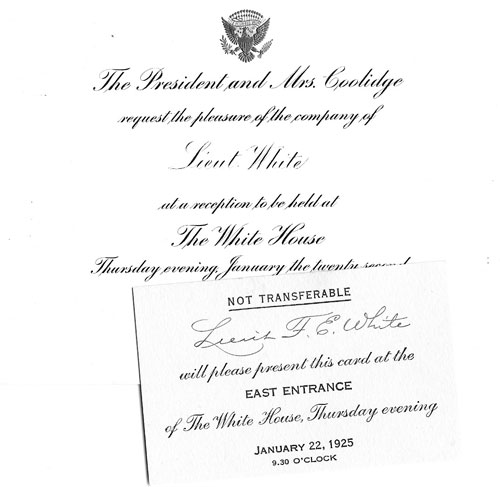
White House invitation
Effective February 1, Frank was appointed 56th Squadron Salvage Officer. Upon his return from leave, Frank also received permission from the Commanding Officer of the 56th Service Squadron to make a cross country flight to Hampton, Va., on or about February 23, returning two days later. Capt. John Platt, Jr., accompanied White as an observer.
In March Frank was appointed Assistant Engineering Officer as well as Cost Officer, and in April was instructed to hold all squadron formations. In April, Major Clagett ordered Frank to be part of a Board of Officers convened to meet at 9:00 a.m., April18, 1925, on or as soon thereafter as practicable, to investigate, place responsibility and estimate the amount of damage incurred as a result of a forced landing of an airplane piloted by Private 1st Class Lewis C. Lee, Jr., an enlisted pilot of the Air Service Tactical School Detachment, upon the property of Mr. L.S. Herbert, Newport, Md., on or about March 14,1925.
“In addition to his other duties”, Frank was detailed as Adjutant, Personnel Adjutant, Prison Officer and OIC Military Police during the time Captain Trunk was absent from duty. Also in late May, he was detailed as a Signal Officer and was responsible for receipts for all property.
JUNE 13, 1925
On Saturday, June 13, 1925, Lieutenant Frank E. White, now 29 years of age, was ordered to proceed to Mitchel Field on Long Island, New York to assist in the training of West Point cadets. He was flying one of three Bolling Field DeHaviland (DH 4B) airplanes with a Lib. 12 engine. Frank‘s plane crashed into the Delaware River near Bristol, Pennsylvania and he was taken unconscious to Harriman Hospital. Major Henry B. Clagett, commanding officer at Bolling Field, went to Bristol, to see the injured officer after the crash. He would be joined by Capts. W.F. Volandt and E.G. Reinartz, and Lieuts. L.V. Beau, Jr., and E.E. Harmon, all of Bolling Field.
From information obtained by Major Clagett in Bristol, as well as the Bristol Evening Star of Wednesday June 17, “As White approached the Delaware River, motor trouble developed, and he prepared to land on an island. At about 1,000 feet, the motor stopped, and he began a glide for the island with the wind. He overshot the field and immediately nose-dived into the water, falling only a short distance.”
Plane crash in Delaware River
“The other planes, piloted by 1st Lieut. Edwin R. McReynolds and 2nd Lt. William L. Scott, Jr., seeing Lieut. White in trouble, made a safe landing. It was declared here today that if the wind had been against Lieut. White’s plane he could have landed safely. Examination revealed he was suffering from lacerations over the right eye, a fracture to the cartilage of the nose, an abrasion of the chin and a puncture wound on the left leg below the knee. Physicians sent word to Washington that the officer was not in serious condition, but later internal injuries were discovered. There was no one in the plane with Lieut. White at the time.”
While having had two previous accidents, the flight report states that Frank’s general ability as a pilot was “very good”. He had approximately 1,060 flying hours as a pilot and averaged 12 hours of flying time per month over the last three months. The total flying time since the last overhaul of the aircraft (A.S. No. 221186) had been 123 hours: 13 minutes, and the engine (A.S. No. 31396 X G) had 56 hours: 34 minutes. Capt. L.L. Snow, A.S. had last inspected the airplane on June 12, 1925, a day before the crash. Weather conditions were good. The pilot who flew this aircraft on the previous flight stated that “everything was in good condition”.
Frank received several Western Union Telegrams, four of which were from girls, Happy, Mabel, Anabell and Mona, and one from his sister in Memphis, Mrs. M. (Margaret) E. Brown of 1484 Faxon Ave. Both Frank and his sister Margaret were orphans and were raised by an aged aunt in Beaverton, Ontario, Canada. The doctors and Major Clagett corresponded with appropriate parties by telegram.
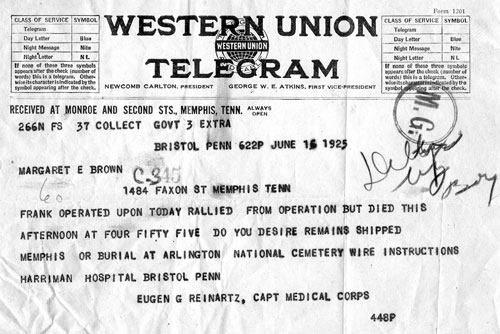
Western Union Telegram - June 16, 1925
Captain Eugene G. Reinartz, Medical Corps, reported that Frank was operated on Tuesday, June 16, and rallied from the operation, but died that afternoon at 4:45 p.m. Lieut. White was the first Bolling Field pilot to die from an airplane accident since 1921, when on May 30 of that year, Lieut. Stanley Ames crashed on the field and was killed.
Lieutenant White’s body was brought to Washington and the family chose to bury him in Arlington National Cemetery the following day (not far from his friend 1st Lieut. George Burgess). His sister Margaret, accompanied the body to Washington.
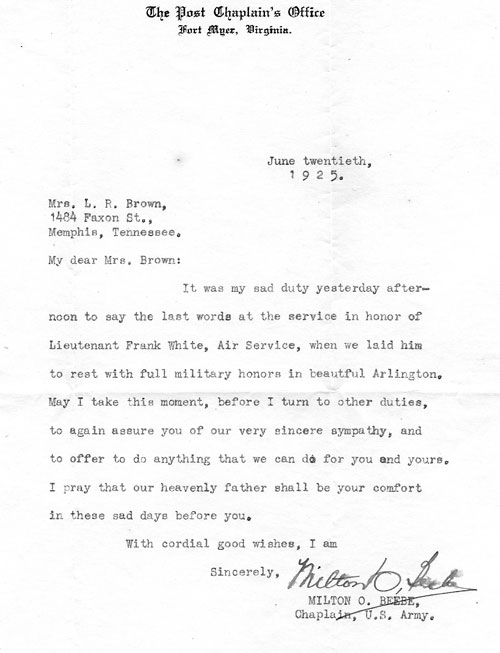
Letter from the Chaplain, U.S. Army
One of the more poignant letters written to his sister Margaret was from one of Frank’s female friends, Mabel M. Donnelly. She writes:
1633- 16th St., N.W. Washington
August 10, 1925My dear Mrs. Brown:
Having been a very close friend for about 6 years of your brother, Frank, who left us almost two months ago. I have been intending for some time to communicate with you. It was my deepest regret that I did not have an opportunity to call on you when you were here.
Word of Frank’s untimely death I know was a severe shock to you, as it was to us all, and my heart surely went out to you. (He had often spoken to me of you and of his uncle who, as I remember he said, reared him). My one special regret was that I did not go to Harriman, Pa., immediately following his accident, as I had first intended, rather I had planned on going to see him the following weekend. It was not until Sunday evening after his fall that I heard of same and immediately I sent him a night letter, followed by a special delivery letter the next day. I have longed to know whether either of these reached him and thought possibly you could tell me. (A quick look at the dates on the Western Union Telegrams indicates that he received her telegram prior to his death). We were together the Friday evening before his accident and departed rather unfriendly, which was probably mostly my fault and I have certainly suffered penance for same. He asked to see me the following evening, in which event he would get authority to delay going to New York until Sunday. I admit I was very disagreeable and refused, so he stated he would phone me the next day to see if I had changed my mind. The following day I had a number of calls – and the servant said it was the same voice each time—but not being here I do not know from whom they came—or whether it was he.
Frank was always so sweet and lovely to me, and now when I reflect I don’t see how I could have been so disagreeable. He had so many plans for the future. I remember of his speaking once about birthdays; mine is Aug 4, his Aug 8th & Lt. & Mrs. Burgess, fiends of his at Bolling Field, sometime the latter part of July, so he said we would have to have our celebration together about the first of August. It’s these many little things that keep him uppermost in my thoughts now. I may also say here that I have Frank’s tuxedo scarf and will send it to you. The last evening we were together I noticed that he had it in a lump in his pocket so, on offering to launder it for him, he gave it to me.
Last Saturday afternoon I took some flowers out to Frank’s grave and it may be of interest to you to know that there were two other bunches of flowers from Gude’s Florist Shop, on his grave. On one card, which was prominent, was Mrs. Stringer and Mr. Wm. White, being the former’s calling card. On the other bunch was a card in an envelope, so I did not look inside.
Everyone who knew Frank thought a great deal of him, and felt his death deeply but it had at last one redeeming fixture – that he died in his glory, - in the service of the stars and stripes.
If at any time, there is anything I can do for you here, Mrs. Brown, in any way whatever, please do not hesitate to call upon me. I shall visit Frank’s grave from time to time and should anything go wrong I shall be glad to inform you. This, loneliness, if improbable, as Arlington is so well kept and his grave is so health-fully located. Again expressing my heartfelt sympathy, believe me.
Very sincerely yours,
Mabel M. Donelly
Frank’s personal possessions were inventoried and authorized for shipping on September 1, 1925. Two chests and two trunks containing a total 990 pounds were shipped via the Baltimore and Ohio Railroad and then the Illinois Central to reach his sister’s home in Memphis. It was with Frank’s insurance money that Margaret bought a new home on University across from Rhodes College (formerly Southwestern at Memphis) football field.
Frank Edward White (Grave 2876) is buried in Arlington Cemetery, Section 4, in the southwest corner of the cemetery above Pershing Drive. George T. Fox, M.D. of Bristol, Pennsylvania expressed it best when he said, “The loss of such a man is sad indeed. He has left us a definite pleasant memory, and “memory is the only friend that grief can call its own”.
Do you know more about this person? Click here to email the author.
References
- U.S. Army Registration Card, Frank E. White
- The Frank E. White Collection
Image Credits
- The Frank E. White Collection
- Army Air Service Photo School
- U.S. Army Air Service Engineering Division, Dayton, Ohio
- United States Army Documents
- G. Andrew Pouncey
